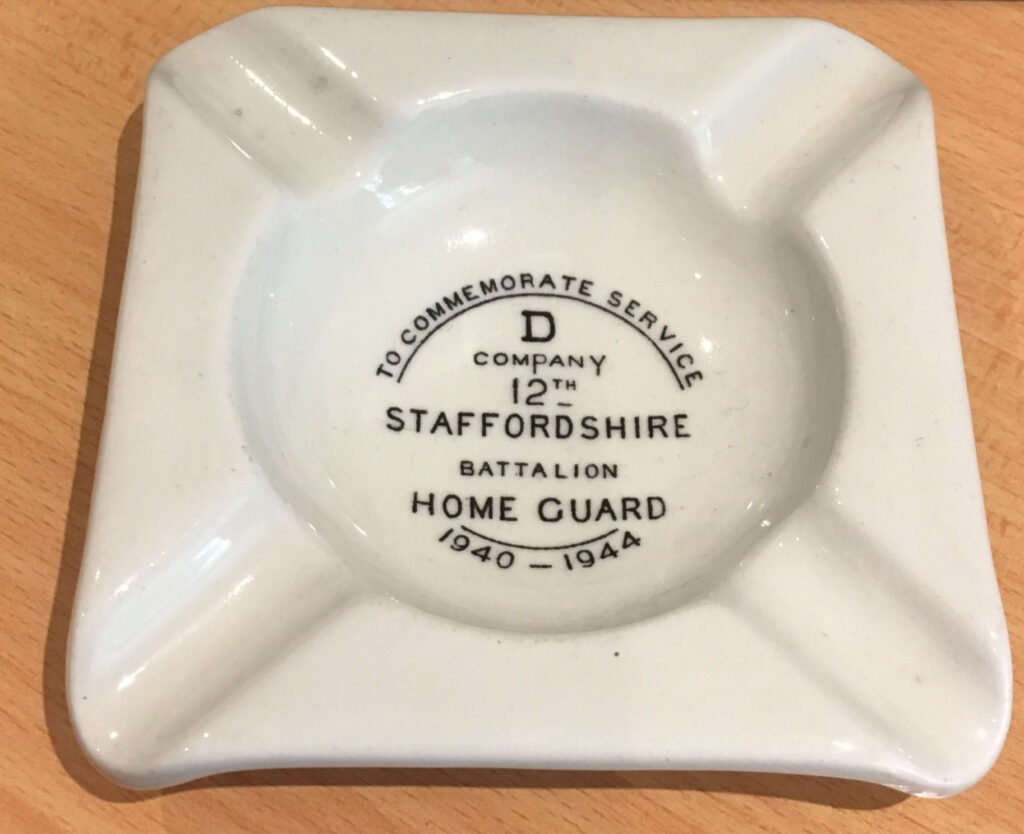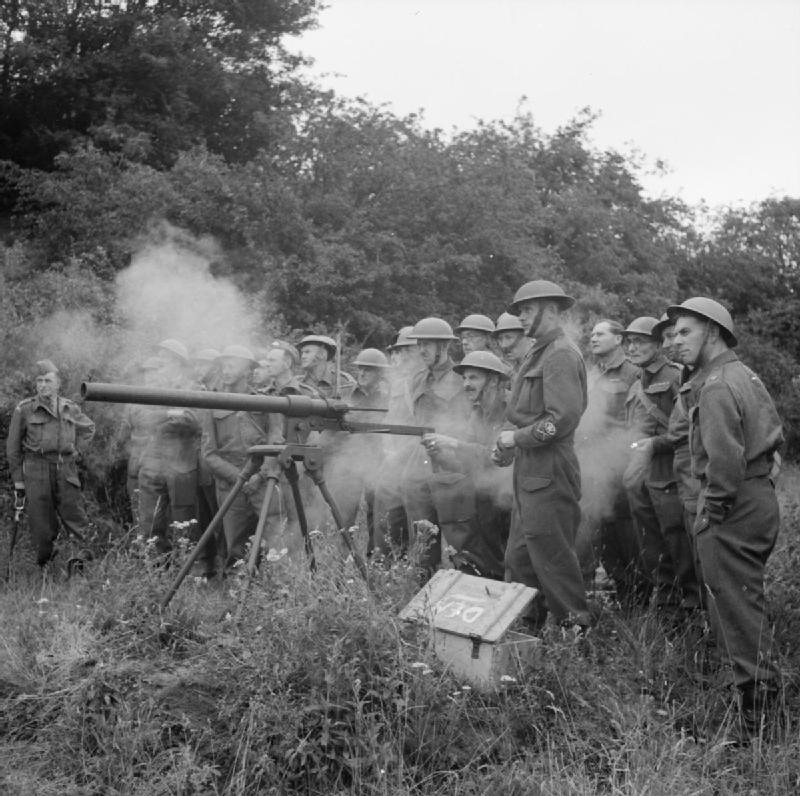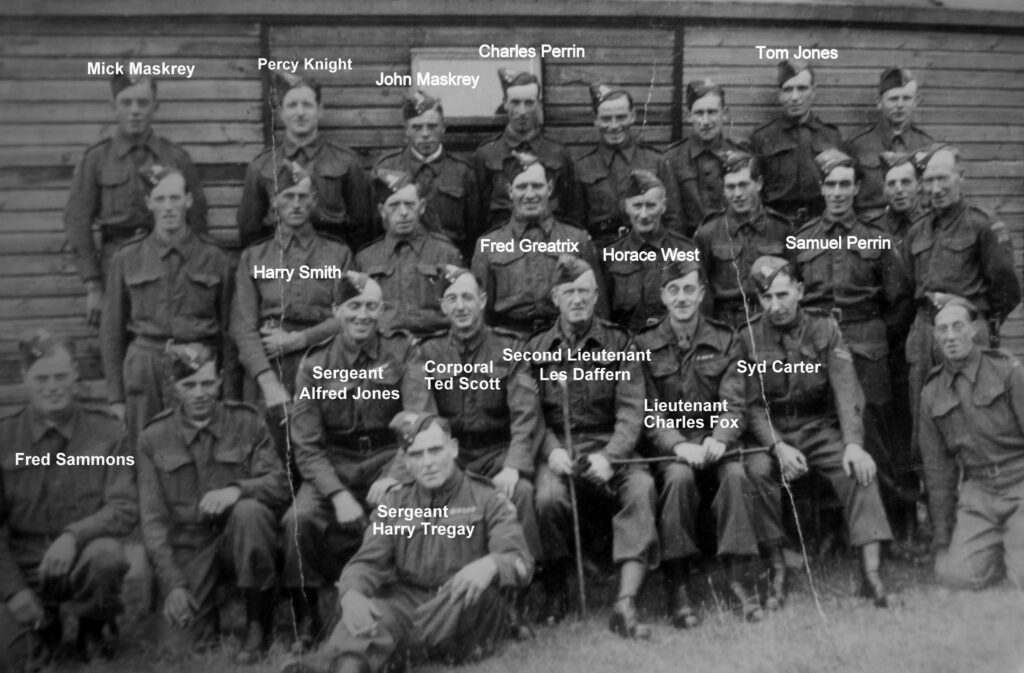
One of these ashtrays, manufactured by Edward Johns & Co. Ltd., was presented to each member of D Company, 12th Battalion of the Staffordshire Home Guard. D company was made up of platoons from Armitage, Handsacre, Longdon, Blithbury and the Ridwares. The Company Commander was Ken Stott who was later promoted to Major in charge of the whole battalion. His brother, Alan, broke his back at some time in the 1930s so couldn’t join the Regular Army – he was a Lieutenant in command of Kings Bromley platoon, H Company, 10th Battalion of the Staffordshire Home Guard.
By mid-May 1940 the British Expeditionary Force (BEF) was under severe pressure following the German invasion of Holland and Belgium. On 14th May 1940, Anthony Eden made his first speech as Secretary of State for War. Part of this speech was asking for volunteers for a force to be called the Local Defence Volunteers:
‘We want large numbers of such men in Great Britain who are British subjects, between the ages of seventeen and sixty-five, to come forward now and offer their services The name of the new force which is now to be raised will be the Local Defence Volunteers. This name describes its duties in three words. You will not be paid, but you will receive uniforms and will be armed. In order to volunteer, what you have to do is give your name at your local police station, and then, when we want you, we will let you know…’
This statement showed the panic created by what at the time seemed to be the inevitable surrender of the BEF. The government only expected 500,000 volunteers but in the event police stations countrywide, including Handsacre and Rugeley, were inundated with volunteers within minutes of the end of the broadcast and three times that number volunteered. The government had no uniforms, no arms and couldn’t decide whether it was a military force or not so initial ranks were Zone Commanders, Platoon and Section Commanders and the term Private was replaced by Volunteer.
The first (known) local parade of the LDV took place in the playground at Rugeley Grammar School. For the first rifle drill they used dummy rifles borrowed from the Drill Hall and locally purchased broomsticks. Alan Stott sent a letter to all members of his platoon stating ‘Will all who have 12 Bore Guns and who are prepared to bring them for action use should the “balloon go up”, please write their names at the foot of this notice. Ball ammunition is obtainable for these Guns – 12 Bore only – but we must know how many Guns there are in order to receive the Army issue. It will be too late on the day of the invasion!’
The sight of older men who probably had fought in the first World War parading in their civilian clothes and without military equipment gave rise to various derogatory nicknames for the LDV – ‘Look, Duck & Vanish’, ‘Last Desperate Venture’ or ‘Long Dentured Veterans’. In July 1940 Winston Churchill decided the name should be changed to Home Guard and the Rugeley Battalion was badged as North Staffords. (Some employers like the Post Office had set up their own LDVs around the country and the Rugeley employees were badged Sherwood Foresters because the Post Office was administered from Nottingham).
D Company Headquarters was at The Brickyard, New Road, Armitage (near where the junction is now with Millmoor Avenue). All members were given white glazed tiles which were to be fitted on their front door so that the Police or Special Constabulary would know where they lived if they had to be contacted in an emergency. The first piece of ‘uniform’ received was an LDV armband but before long they received caps and then denims of the British Army pattern.
During July 1940 a consignment of US Army bolt action rifles – Springfields and Winchesters – were received. These had been coated in grease since the end of World War 1 and took about two weeks to get into working condition. The officers were each given Colt .45 pistols which had been donated by private US citizens. Browning automatic rifles and Thompson sub-machine guns were eventually received but no anti-tank weapons so Molotov cocktails were introduced. These are spirit bottles filled with a mixture of paraffin, tar and petrol with an inflammable fuse held in place by a cork. The basic idea is to light the fuse and then throw the bottle at the tank from a very close range.

The British Army had to leave behind nearly a thousand anti-tank guns when they evacuated Dunkirk leaving them with less than two hundred in the whole of the UK. There was so little ammunition for them that no rounds were allowed for practice firing. A Home Guard Major, Harry Northover, designed a very low cost weapon which, after a demonstration to Winston Churchill, was rapidly put into mass production. Without the tripod it cost less than £10 to manufacture and consisted of a hollow metal tube, (resembling a drain pipe), with a breech at one end and was mounted on a cast iron tripod. It was fired with a small quantity of black powder, had an effective range of about 100 yards, and, for best effect, was used with a No.76 incendiary grenade although other grenades could be fired. This photo shows Home Guardsmen from Saxmundham being trained on the Projector. One drawback was the weight and many platoons modified them to fit on wheeled carts. Eventually each Home Guard platoon was provided with a Projector.
During August and September 1940 the Home Guard were generally on a state of constant alert. The average Home Guard, (officially aged between 17 and 65 but a blind eye was turned at both ends of that range), had already completed a full days work on the land, down the pit or at the pottery then did three night a week on Home Guard duty, often followed by weekend exercises. This was all, remember, without pay.
On 3rd September, Hitler set 21st September for the beginning of the invasion of Britain with the proviso that it could be cancelled up to 24 hours beforehand. Small ships and barges started moving from Ostend to Le Havre and 160 long range bombers were transferred from Norway to the Channel coast. German air attacks had for some time been concentrating on airfields and aircraft factories to provide air superiority over the landing beaches. Groups of Germans were sent to Britain to report on the movement of British reserve troops. Four Germans were captured landing on the south-east coast and under interrogation said that they were supposed to be ready for their reports at any time over the next two weeks.
All these facts, together with information on the moon and tide suggested that the likely invasion date was 8-10th September so, at 8pm on 7th September, British Military Headquarters issued the codeword “Cromwell” to all forces signifying “invasion imminent”. All military forces including the Home Guard were ordered to go on immediate alert. On the following morning (8th September), General Headquarters, Home Forces, gave instructions that the Home Guard were not to be permanently called out on receipt of the code word “Cromwell,” except for special tasks; also, that church bells were to be rung only by order of a Home Guard who had himself seen at least 25 parachutists landing.
Each person had to be trained in a wide range of weaponry, most of it out of date. The Company was trained on 29mm Spigot Mortars which fired a 20lb high explosive round. By 1942 though supply of weapons improved and the Company received Lewis Guns, Bren Guns, Boyes Anti-Tank Rifles, Browning Medium Machine Guns, 9mm Sten-guns, and Vickers Heavy Machine Guns.
During 1941 the Home Guard was involved in a number of large scale exercises against other Home Guard units, Regular Army and Allied troops. One night exercise was in the Trent Valley area against Polish parachutists. The whole of the 12th Battalion also took part in September 1941 in a three day exercise defending Slitting Mill and Rugeley pumping station against the Sherwood Foresters. The only occasion when D Company was called into actual operations was in 1942 when ten Italian prisoners-of-war escaped from the Hednesford Road camp near Rugeley and they scoured the Parish for them. The Italians were eventually recaptured near Brocton by the 13th (Cannock) Battalion.
Members of the Home Guard were either in reserved occupations, too young or too old to serve in the normal army. A reserved occupation is a job which was deemed as vital to the war effort. The age limit for members of the Home Guard was officially 17 to 65. As you could not enrol in the Regular Army until you were 18 a large number of 17 year olds enlisted in the Home Guard to gain some experience. Originally all members of the Home Guard were volunteers. In 1942 the National Service Act made it possible for compulsory enrolment to be applied in areas where units were below strength.

The table below shows all the known Home Guard members for D Company but there are undoubtedly more who actually served. If you have any further information, please contact me.
| Name | Rank | Comment |
|---|---|---|
| Astley | Pte | |
| Appleby | L/c | |
| Astley | Pte | |
| Baker, Alf | Pte | Armitage Platoon |
| Boston, G | Pte | |
| Bradshaw | Pte | |
| Brockhurst, J | Pte | |
| Bushnell,A | Pte | |
| Carter, Charles Sidney | Cpl | Ridware Platoon |
| Chilton, F | L/Cpl | |
| Clifford, H | Pte | |
| Coates, W | C Q M S | |
| Cope, D | Lt | |
| Cubley, W | Cpl | |
| Daffarn, Les | 2/Lt | Ridware Platoon |
| Dunkey, B | Pte | |
| Dunkley, George | Adj | |
| Evans,Reginald DCM | Lt | Armitage Platoon |
| Fisher, J | Pte | |
| Fox, Charles | Lt | Ridware Platoon |
| Frost, W | Cpl | |
| Gray | Lt | |
| Greatrix, Frederick James | Pte | Ridware Platoon |
| Grimley, Jack | Pte | |
| Hall | Pte | |
| Hall, J | Pte | |
| Harley | Pte | |
| Harper | Pte | |
| Harris | Pte | |
| Hill | Cpl | |
| Hill, F | Cpl | |
| Hill, G | Cpl | |
| Hodgkiss, J | Pte | |
| Hollinshead,R | Cpl | Longdon Platoon |
| Hooper,R | Pte | Longdon Platoon |
| Howells, ? G | Cpl | |
| Hyden,S | Sgt | |
| Jefferies, B | Pte | |
| Johnson, R | L/Cpl | |
| Jones Alfred T | Sgt | Ridware Platoon |
| Jones, C | Pte | |
| Jones, Tom | Pte | Ridware Platoon |
| Knight, Percy | Pte | Ridware Platoon |
| Leadbetter, J | Pte | |
| Lees, C | Pte | |
| Leigh, Jack | Pte | |
| Lines | Pte | |
| Marshall, C T (Tom) | Pte | |
| Marson, F | Pte | |
| Maskrey, John | Pte | Ridware Platoon |
| Maskrey, Mick | Pte | Ridware Platoon |
| Matthews, George | Pte | Died 9 Jul 1944 following wounds in Normandy landing |
| Monk,L | Cpl | Longdon Platoon |
| Monk,G | Sgt | Longdon Platoon |
| Norton | Capt | |
| Ottewell, Len | Pte | Armitage Platoon |
| Overton, N | Pte | |
| Page,T | Pte | |
| Perrin, Samuel | Pte | Ridware Platoon |
| Perrin, A | Pte | |
| Perrin, Charles | Pte | Ridware Platoon |
| Perrin, R | Pte | |
| Potts, R | Pte | |
| Sammons, Eddie | Pte | Ridware Platoon |
| Sammons, Ike (Walter) | Pte | Ridware Platoon |
| Sammons, Percy | Pte | Ridware Platoon |
| Sammons, Samuel | Pte | Ridware Platoon |
| Samuels T J | Cpl | |
| Samuels, Thomas | 2nd Lt | |
| T Sanders | Cpl | Bugler |
| Saunders | Pte | |
| Saunders, A J | Pte | |
| Saunders, H | Pte | |
| Scott, Ted | Cpl | Ridware Platoon |
| Shepherd, F | Sgt | |
| Shelley | Sgt | |
| Smallwood | Sgt | |
| Smith, Harry | Pte | Ridware Platoon |
| Smith | Cpl | |
| Spink, Andrew | Pte | Armitage Platoon |
| Stott, C K | Major | |
| Tatlow,J | Pte | |
| Taylor,Joe | Pte | |
| Tregay, Harry | C S M | Ridware Platoon |
| Walker | Pte | |
| Walker, F | Pte | |
| Walker, K | Pte | |
| Walker, P | Pte | |
| Walker, W | Pte | |
| Wallis, O | Pte | |
| Warrington,Lewis Charles | Pte | Ridware Platoon |
| West, Horace | Pte | Ridware Platoon |
| Wilshaw, C | Pte | |
| Wilshaw, R | Pte | |
| Wood, A V | Pte | |
| Wood | Pte | |
| Wright, William G | Lt | Armitage Platoon |
| Yates, J | Sgt |
